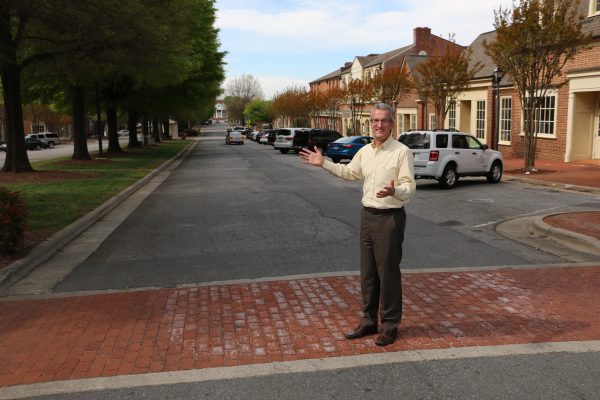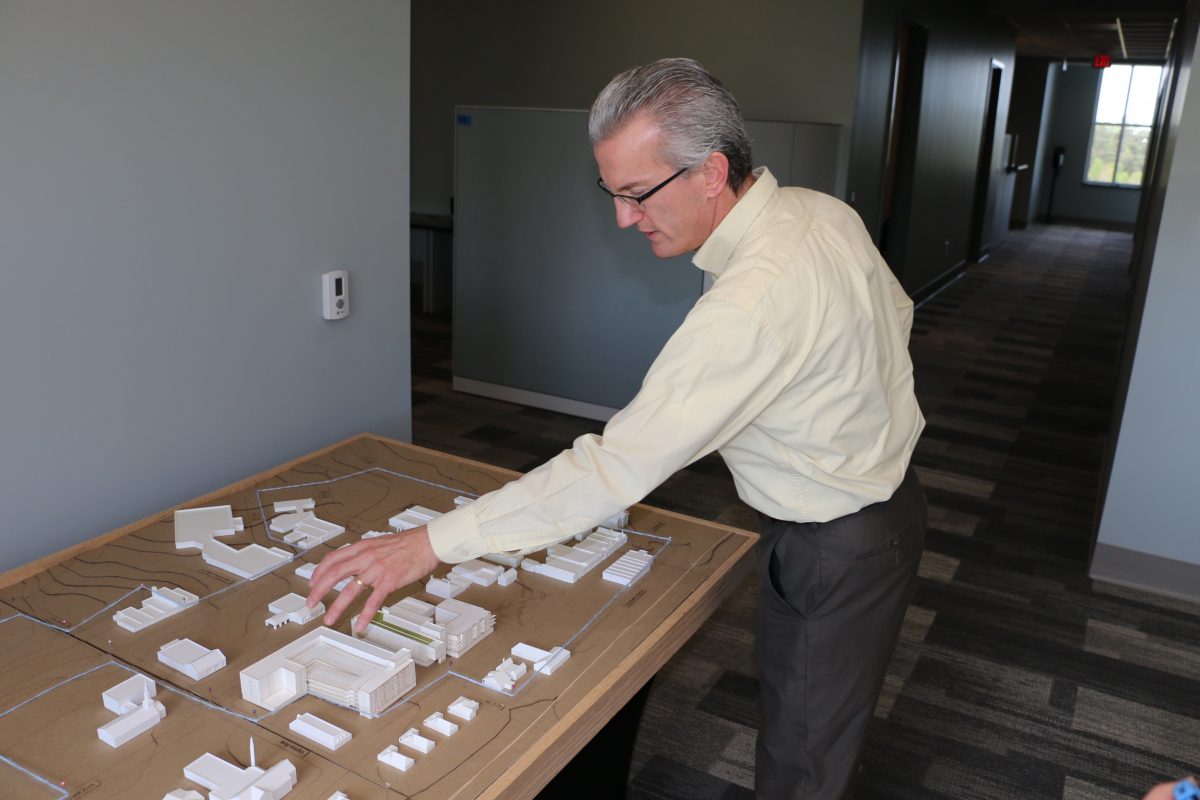Kannapolis, the town that towels built, faces its future

Kannapolis is unlike any other municipality in North Carolina. Founded in 1906, for much of its history it was owned by Cannon Mills, which by 1914 was the world’s largest producer of sheets and towels. Kannapolis was the largest unincorporated community in the United States in 1984, when it finally incorporated as a city two years after billionaire David Murdock bought Cannon Mills. The company kept ownership of downtown Kannapolis.
As the U.S. textile industry faded in the late 20th century, the mill was sold again and again. In 2003 owner Pillowtex, after filing for bankruptcy, closed and 4,340 workers lost their jobs in the largest one-day layoff in N.C. history. In 2004 Murdock, who by then owned Dole Food Co., bought the mill and the downtown—again. He announced plans for a $1.5 billion North Carolina Research Campus on the site of the former mill, which he demolished.
Last year the City of Kannapolis—population 46,000—bought 55 acres downtown from Murdock for $8.75 million. Today, as Planning Director Zachary “Zac” Gordon describes, the city is crafting plans to reinvigorate its central core.
PlanCharlotte’s Mary Newsom talked with Gordon during interviews in January and in April. Edited excerpts are below. Listen to the April discussion on our “PlanCharlotte: Talk of the Towns” podcast.
Q. Tell us about Kannapolis.
A. Kannapolis is a community very much in transition. It was the quintessential mill town or company town. Beginning in 1932-34, Mr. Cannon [Charles Cannon, son of founder J. W. Cannon] built this downtown. He realized the people who worked for him needed someplace to shop, more of a center. What’s known as Cannon Village is a replica – a facsimile – of Williamsburg. You have the neo-Georgian architecture, brick buildings, primarily one story, with a center median down the main drag, a terminated vista—a church on one end and at the other end, Cannon Mills.
Most people are familiar with Cannon Towels. It was a very thriving business. At its height it employed over 20,000 people.
This is a relatively new downtown but it is intact. There’s about 350,000 square feet of usable space. It has stood the test of time. When we were investigating the purchase of downtown we had an assessment done of every building, top to bottom. The buildings are in relatively good shape for 70-plus years.
West Avenue, the main street through downtown, for 70, almost 80 years—from 1935 or so until we purchased it last year—was a private street. Imagine. Now that we own it, it is indeed public.
Q. What’s the state of the Kannapolis economy?
A. Good! The community is growing, and the older population is not leaving. We’re 46,000 and growing. In a half-hour you can get to center city Charlotte. There is a fair amount of growth on our western border, adjacent to Mecklenburg County.
There’s still a significant blue-collar demographic. Kannapolis was a mill village, and the transition from the mill to a 21st-century economy has been somewhat painful. But Kannapolis has a fairly large geographic area, just about 34 square miles in our corporate limits. And we have the ability to annex another 26 square miles, up to 60 square miles total.
Q. Why did the city decide to buy the downtown?
A. Since 2004 when the mill closed, the downtown has languished. The city recognized that unless there was proactive movement, the downtown would continue to languish.
This small rubble pile is all that remains of the former Cannon Mills-Pillowtex plant that once dominated downtown Kannapolis. In the background are buildings of the N.C. Research Campus. Photo: Mary Newsom
The North Carolina Research Campus, an undertaking of Mr. Murdock and his brainchild, does nutrition and health research, a lot of plant-based research to try to come up with some breakthroughs in medicine. The Research Campus was envisioned as a million-square-foot mixed-use employment and technology center. Initially three buildings were put up, about 300,000 square feet. But the economic downturn of 2008 put a damper on the balance of the development. Post-recession, we viewed the Research Campus as a major asset.
In the interim the city decided to acquire the downtown. The owner, Mr. Murdock, agreed to sell to the city.
The downtown is certainly not vibrant. It is well under 50 percent occupancy. But all the bones are here. The research campus employs maybe 300-325.
It’s funny, but in a lot of respects this really reminds me of Birkdale Village in Huntersville. Our job is to inject life back into and really revive what is still the center, geographically, of our city.
We have the seed form of everything we want. We have exactly 11 residential units downtown, and four restaurants. We even have some office.

Gordon,in an unused upstairs room in the old planning office on Main Street, shows a scale model of Kannapolis. Photo: Mary Newsom
Q. Now that you own downtown, what happens next?
A. We are in the final stages of creating a development plan for the downtown. The city has contracted with Development Finance Initiative out of the University of North Carolina Chapel Hill School of Government. They are working on a plan with us that will provide a road map for development. The plan is scheduled to be completed about July and adopted about that time. We’re in the final stages of review.
Q. Are any downtown buildings suitable, in terms of size, for breweries or distilleries?
A. We spoke to someone who was very much interested in a microbrewery, which is all the rage now. My French is not very good, but it is de rigueur—you’ve got to have a microbrewery or a distillery, or something to attract the Millennials.
Q. Looking 10 years out, what would you like to see in downtown Kannapolis?
A. The biggest change we would like to see is the reintroduction of residential growth downtown. There’s a void. Along with that comes the support retail and commercial. We did have a market study which gives us a fairly good forecast for what the downtown can support. The downtown plan will dovetail with that.
Something we’re focusing on now is getting people from outside the community into the downtown. Downtowns still attract people. As nice as Afton Ridge [a Kannapolis shopping center] is, it’s not a downtown.
The single-screen Gem Theatre on West First Street is an Art Deco building dating to the 1930s. It still shows first-run movies – for $5 for adults, $4 for kids and seniors. Photo: Mary Newsom
Q. Talk a little bit to the planners in our audience. What kind of zoning do you have, and what’s next in terms of planning?
Click image to download a larger view of map of property acquired by the city.
A. Originally, in the first zoning ordinance in 1988, we had a conventional code. In 2000 the city adopted a Unified Development Ordinance (UDO), which has some form-based elements in the downtown as well as some of the development corridors. So it is a hybrid of sorts. But it certainly allows for the kind of quality development we want to see in our downtown. Buildings have got to front public streets, squares or a plaza. There’s got to be public accessibility and activation on the ground floor with retail or some other activity. Once the development plan is adopted, that will provide an additional level that we’ll have to adhere to.
The city is about to embark on an update to its comprehensive plan. It’s probably the most important document the city has or will put together in 100 years. It sets the foundation for the next century for Kannapolis.
Q. The city has a beautiful new City Hall that opened in December. But has this beautiful, very large building provoked any citizen concern that it’s just too majestic?
A. Not at all. I think maybe because for 31 years they had no City Hall, maybe there’s a feeling like, wow, it’s about time. And maybe there’s a reservoir of regret. Kannapolis was a hub. Kannapolis was a happening place. When we had our ceremonial opening in December, we had a packed house. A number of the people were older residents who had been here when the mill was in its heyday. The community is very proud of this building.
Q. What cities have you looked to as models?
A. Within the region certainly the marquee example is Charleston, South Carolina, a world-class destination. Greenville, South Carolina, is another great example of, 25 years ago, a very intentional decision by the city to create a master plan and stick with it.
We realize there’s a lot of work to be done, but I think the key is the plan that we’re putting together, that ultimately will serve as the road map for that kind of renaissance in our downtown.
We have all the raw materials and we have all the potential to make Kannapolis a thriving community and for the downtown to be a thriving downtown. What do we need to do to take all the potential and to energize and activate it? It all starts with a plan. I’m very big on setting up a vision and a plan and working with that plan. Most great cities, nationally and internationally, had a plan.
Q. You spent a number of years in Huntersville, a fast-growing suburb in northern Mecklenburg County, and came to Kannapolis in 2014. What attracted you to this job?
A. This is a dream job for any planner who is interested in change. This is what I’ve wanted to do for 25 years. I’m invested in this community. I want to see Kannapolis thrive. This is absolutely the capstone of my career.

Gordon shows a scale model of the downtown in a room at the new City Hall. Photo: Mary Newsom


